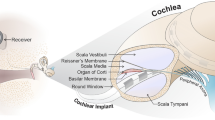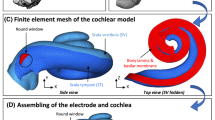Abstract
Cochlear implantation (CI) surgery is a very successful technique, performed on more than 300,000 people worldwide. However, since the challenge resides in obtaining an accurate surgical planning, computational models are considered to provide such accurate tools. They allow us to plan and simulate beforehand surgical procedures in order to maximally optimize surgery outcomes, and consequently provide valuable information to guide pre-operative decisions. The aim of this work is to develop and validate computational tools to completely assess the patient-specific functional outcome of the CI surgery. A complete automatic framework was developed to create and assess computationally CI models, focusing on the neural response of the auditory nerve fibers (ANF) induced by the electrical stimulation of the implant. The framework was applied to evaluate the effects of ANF degeneration and electrode intra-cochlear position on nerve activation. Results indicate that the intra-cochlear positioning of the electrode has a strong effect on the global performance of the CI. Lateral insertion provides better neural responses in case of peripheral process degeneration, and it is recommended, together with optimized intensity levels, in order to preserve the internal structures. Overall, the developed automatic framework provides an insight into the global performance of the implant in a patient-specific way. This enables to further optimize the functional performance and helps to select the best CI configuration and treatment strategy for a given patient.










Similar content being viewed by others
References
Erixon E, Högstorp H, Wadin K, Rask-Andersen H (2009) Variational anatomy of the human cochlea. Otol Neurotol 30:14–22. doi:10.1097/MAO.0b013e31818a08e8
Green K, Bhatt Y, Mawman D, O’Driscoll M, Saeed S, Ramsden R, Green M (2007) Predictors of audiological outcome following cochlear implantation in adults. Cochlear Implants Int 8:1–11. doi:10.1002/cii.326
Mangado N, Ceresa M, Dejea H, Kjer HM, Vera S, Paulsen RR, Fagertun J, Mistrik P et al. (2015) Monopolar stimulation of the implanted cochlea: a synthetic population-based study. Lecture Notes in Computer Science, vol. 9401 (Clinical Image-Based Procedures: Translational Research in Medical Imaging, MICCAI-CLIP 2015), pp 96–103
Lee H-J, Giraud A-L, Kang E, Oh S-H, Kang H, Kim C-S, Lee DS (2006) Cortical activity at rest predicts cochlear implantation outcome. Cereb Cortex 17:909–917. doi:10.1093/cercor/bhl001
Giraud A-L, Lee H-J (2007) Predicting cochlear implant outcome from brain organisation in the deaf. Restor Neurol Neurosci 25:381–390.
Kalkman RK, Briaire JJ, Frijns JHM (2015) Current focussing in cochlear implants: an analysis of neural recruitment in a computational model. Hear Res 322:89–98. doi:10.1016/j.heares.2014.12.004
Rattay F, Leao RN, Felix H (2001) A model of the electrically excited human cochlear neuron. II. Influence of the three-dimensional cochlear structure on neural excitability. Hear Res 153:64–79. doi:10.1016/S0378-5955(00)00257-4
Ceresa M, Mangado N, Andrews RJ, González Ballester MA (2015) Computational models for predicting outcomes of neuroprosthesis implantation: the case of cochlear implants. Mol Neurobiol 52:934–941. doi:10.1007/s12035-015-9257-4
Nogueira W, Schurzig D, Büchner A, Penninger RT, Würfel W (2016) Validation of a cochlear implant patient-specific model of the voltage distribution in a clinical setting. Front Bioeng Biotechnol. doi:10.3389/fbioe.2016.00084
Sibella F, Parazzini M, Pesatori A, Paglialonga A, Norgia M, Ravazzani P, Tognola G (2007) Modeling and computation of electric potential field distribution generated in cochlear tissues by cochlear implant stimulations. In: 2007 3rd Int. IEEE/EMBS Conf. Neural Eng. IEEE, pp 506–509
Zhu Z, Tang Q, Zeng F-GG, Guan T, Ye D (2012) Cochlear-implant spatial selectivity with monopolar, bipolar and tripolar stimulation. Hear Res 283:45–58. doi:10.1016/j.heares.2011.11.005
Ceresa M, Mangado Lopez N, Dejea Velardo H, Carranza Herrezuelo N, Mistrik P, Kjer HM, Vera S, Paulsen RR, González Ballester MA (2014) Patient-specific simulation of implant placement and function for cochlear implantation surgery planning. Lecture Notes in Computer Science, vol. 8675 (Medical Imaging and Computer Assisted Intervention - MICCAI), pp 49–56
Briaire JJ, Frijns JHM (2006) The consequences of neural degeneration regarding optimal cochlear implant position in scala tympani: a model approach. Hear Res 214:17–27. doi:10.1016/j.heares.2006.01.015
Zhang X, Gan RZ (2011) A comprehensive model of human ear for analysis of implantable hearing devices. IEEE Trans Biomed Eng 58:3024–3027. doi:10.1109/TBME.2011.2159714
Tran P, Sue A, Wong P, Li Q, Carter P (2015) Development of HEATHER for cochlear implant stimulation using a new modeling workflow. IEEE Trans Biomed Eng 62:728–735. doi:10.1109/TBME.2014.2364297
Malherbe TK, Hanekom T, Hanekom JJ (2016) Constructing a three-dimensional electrical model of a living cochlear implant user’s cochlea. Int J Numer Method Biomed Eng 32:e02751. doi:10.1002/cnm.2751
Smit JEE, Hanekom T, Hanekom JJJ (2008) Predicting action potential characteristics of human auditory nerve fibres through modification of the Hodgkin-Huxley equations. S Afr J Sci 104:284–292
Rattay F, Lutter P, Felix H (2001) A model of the electrically excited human cochlear neuron. Hear Res 153:43–63. doi:10.1016/S0378-5955(00)00256-2
Malherbe TK, Hanekom T, Hanekom JJ (2013) Can subject-specific single-fibre electrically evoked auditory brainstem response data be predicted from a model? Med Eng Phys 35:926–936. doi:10.1016/j.medengphy.2012.09.001
Kalkman RK, Briaire JJ, Dekker DMT, Frijns JHM (2014) Place pitch versus electrode location in a realistic computational model of the implanted human cochlea. Hear Res 315:10–24. doi:10.1016/j.heares.2014.06.003
Frijns JHM, de Snoo SL, Schoonhoven R (1995) Potential distributions and neural excitation patterns in a rotationally symmetric model of the electrically stimulated cochlea. Hear Res 87:170–186. doi:10.1016/0378-5955(95)00090-Q
Briaire JJ, Frijns JHM (2005) Unraveling the electrically evoked compound action potential. Hear Res 205:143–156. doi:10.1016/j.heares.2005.03.020
Saba R, Elliott SJ, Wang S (2014) Modelling the effects of cochlear implant current focusing. Cochlear Implants Int 15:318–326. doi:10.1179/1754762814Y.0000000081
Hughes ML, Abbas PJ (2006) Electrophysiologic channel interaction, electrode pitch ranking, and behavioral threshold in straight versus perimodiolar cochlear implant electrode arrays. J Acoust Soc Am 119:1538. doi:10.1121/1.2164969
Long CJ, Holden TA, McClelland GH, Parkinson WS, Shelton C, Kelsall DC, Smith ZM (2014) Examining the electro-neural interface of cochlear implant users using psychophysics, CT scans, and speech understanding. JARO-J Assoc Res Otolaryngol 15:293–304. doi:10.1007/s10162-013-0437-5
Kang S, Chwodhury T, Moon IJ, Hong SH, Yang H, Won JH, Woo J (2015) Effects of electrode position on spatiotemporal auditory nerve fiber responses: a 3D computational model study. Comput Math Methods Med 2015:1–13. doi:10.1155/2015/934382
van der Beek FB, Briaire JJ, van der Marel KS, Verbist BM, Frijns JHM (2016) Intracochlear position of cochlear implants determined using CT scanning versus fitting levels: higher threshold levels at basal turn. Audiol Neurotol 21:54–67. doi:10.1159/000442513
Venail F, Mura T, Akkari M, Mathiolon C, Menjot de Champfleur S, Piron JP, Sicard M, Sterkers-Artieres F, Mondain M, Uziel A (2015) Modeling of auditory neuron response thresholds with cochlear implants. Biomed Res Int 2015:1–10. doi:10.1155/2015/394687
Wanna GB, Noble JH, Carlson ML, Gifford RH, Dietrich MS, Haynes DS, Dawant BM, Labadie RF (2014) Impact of electrode design and surgical approach on scalar location and cochlear implant outcomes. Laryngoscope 124:S1–S7. doi:10.1002/lary.24728
Davis TJ, Zhang D, Gifford RH, Dawant BM, Labadie RF, Noble JH (2016) Relationship between electrode-to-modiolus distance and current levels for adults with cochlear implants. Otol Neurotol 37:31–37. doi:10.1097/MAO.0000000000000896
Greenwood DD (1990) A cochlear frequency-position function for several species—29 years later. J Acoust Soc Am 87:2592–2605
Mangado N, Ceresa M, Duchateu N, Kjer HM, Vera S, Dejea Velardo H, Mistrik P, Paulsen RR, Fagertun J, Noailly J, Piella G, González Ballester MA (2016) Automatic model generation framework for computational simulation of cochlear implantation. Annals of Biomedical Engineering 44(8):2453–2463. doi:10.1007/s10439-015-1541-y
Kjer HM, Vera S, Fagertun J, González Ballester MA, Paulsen R (2015) “Predicting detailed inner ear anatomy from pre-operational CT for cochlear implant surgery,” Int J Comput Assist Radiol Surg, vol. 10 (Suppl 1- computer assisted radiology and surgery, Barcelona, Spain), pp. 98-99
Kjer HM, Fagertun J, Vera S, Gil D, González Ballester MA, Paulsen RR (2016) Free-form image registration of human cochlear μCT data using skeleton similarity as anatomical prior. Pattern Recognition Letters 76:76–82. doi:10.1016/j.patrec.2015.07.017
Duchateau N, Mangado N, Ceresa M, Mistrik P, Vera S, González Ballester MA (2015) Virtual cochlear electrode insertion via parallel transport frame. In: IEEE, New York International Symposium on Biomedical Imaging (ISBI), pp 1398–1401. doi:10.1109/ISBI.2015.7164137
Wong P, George S, Tran P, Sue A, Carter P, Li Q (2016) Development and validation of a high-fidelity finite-element model of monopolar stimulation in the implanted guinea pig cochlea. IEEE Trans Biomed Eng 63:188–198. doi:10.1109/TBME.2015.2480601
Ruokolainen J, Lyly M (2000) ELMER, a computational tool for PDEs—application to vibroacoustics. CSC-News 12:30–32
Stickney GS, Loizou PC, Mishra LN, Assmann PF, Shannon RV, Opie JM (2006) Effects of electrode design and configuration on channel interactions. Hear Res 211:33–45. doi:10.1016/j.heares.2005.08.008
Hodgkin AL, Huxley AF (1952) A quantitative description of membrane current and its application to conduction and excitation in nerve. Bull Math Biol 117:500–544. doi:10.1007/BF02459568
Stakhovskaya O, Sridhar D, Bonham BH, Leake P a. (2007) Frequency map for the human cochlear spiral ganglion: implications for cochlear implants. J Assoc Res Otolaryngol 8:220–233. doi:10.1007/s10162-007-0076-9
Vanpoucke FJ, Boermans PB, Frijns JH (2012) Assessing the placement of a cochlear electrode array by multidimensional scaling. IEEE Trans Biomed Eng 59:307–310. doi:10.1109/TBME.2011.2173198
Berenstein CK, Vanpoucke FJ, Mulder JJS, Mens LHM (2010) Electrical field imaging as a means to predict the loudness of monopolar and tripolar stimuli in cochlear implant patients. Hear Res 270:28–38. doi:10.1016/j.heares.2010.10.001
Choi CTM, Lai W-D, Lee S-S (2006) A novel approach to compute the impedance matrix of a cochlear implant system incorporating an electrode-tissue interface based on finite element method. IEEE Trans Magn 42:1375–1378. doi:10.1109/TMAG.2006.872461
Brill S, Müller J, Hagen R, Möltner A, Brockmeier S-J, Stark T, Helbig S, Maurer J, Zhanert T, Zierhofer C, Nopp P, Anderson I, Strahl S (2009) Site of cochlear stimulation and its effect on electrically evoked compound action potentials using the MED-EL standard electrode array. Biomed Eng Online 8:40. doi:10.1186/1475-925X-8-40
Saunders E, Cohen L, Aschendorff A, Shapiro Wand Knight M, Stecker M, Richter B, Waltzman S, Tykocinski M et al. (2002) Threshold, comfortable level and impedance changes as a function of electrode-modiolar distance. Ear Hear 23:28S–40S
Gstoettner W, Kiefer J, Baumgartner W, Pok S, Peters S, Adunka O (2004) Hearing preservation in cochlear implantation for electric acoustic stimulation. Acta Otolaryngol 124:348–352
Mangado N, Pons-Prats J, Ceresa M, Bugeda G, González Ballester MA (2016) Intracochlear potential prediction accounting for bone conductivity uncertainty. European Congress on Computational Methods in Applied Sciences and Engineering (ECCOMAS)
Funding
This work was financially supported by the European Commission (FP7 project number 304857, HEAR-EU), Generalitat de Catalunya (PRODUCTE program, project number 2016PROD00047) and the Spanish Ministry of Economy and Competitiveness under the Maria de Maeztu Units of Excellence Programme (MDM-2015-0502).
Author information
Authors and Affiliations
Corresponding author
Rights and permissions
About this article
Cite this article
Mangado, N., Ceresa, M., Benav, H. et al. Towards a Complete In Silico Assessment of the Outcome of Cochlear Implantation Surgery. Mol Neurobiol 55, 173–186 (2018). https://doi.org/10.1007/s12035-017-0731-z
Published:
Issue Date:
DOI: https://doi.org/10.1007/s12035-017-0731-z




